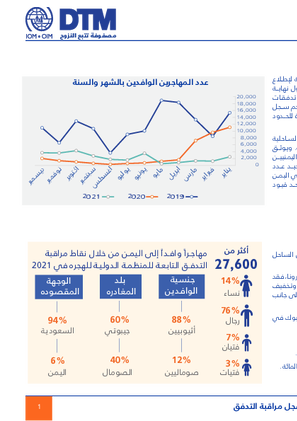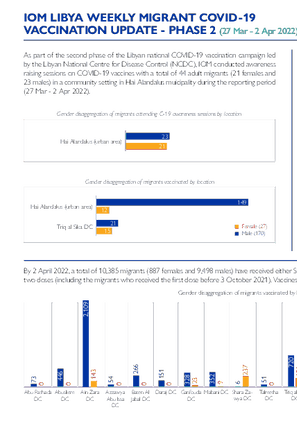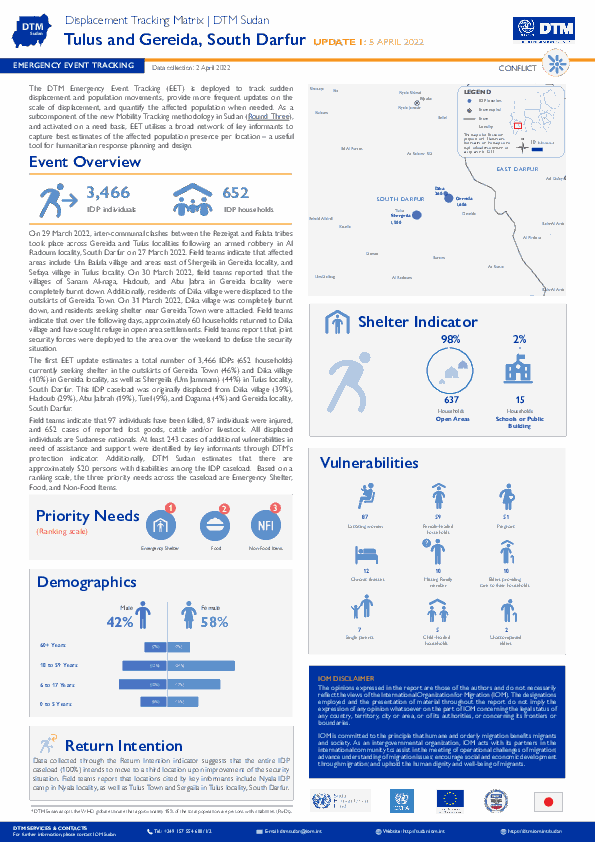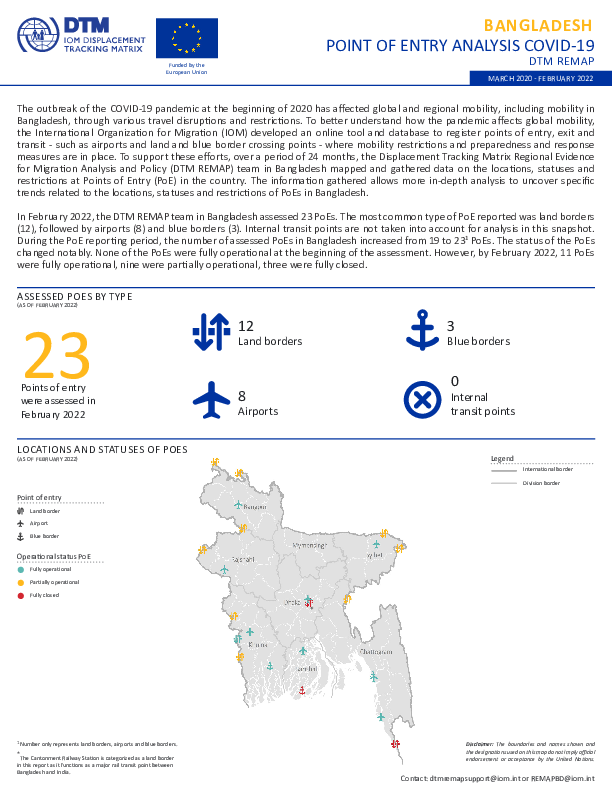-
Countries
-
Data and Analysis
-
Special Focus
-
Crisis Responses

Contact
DTM South Sudan, SouthSudanDTM@iom.int
Language
English
Location
South Sudan
Period Covered
Oct 01 2021
Oct 31 2021
Activity
- Flow Monitoring
DTM’s Flow Monitoring Registry (FMR) surveys people on the move at key transit points within South Sudan (SSD) and at its borders. It provides an insight into mobility trends, migration drivers and traveller profiles to inform programming by humanitarian and development partners and by the government, complementing DTM’s monitoring of COVID-19 mobility restrictions. In total, 24 Flow Monitoring Points (FMPs) were active in October 2021, surveying internal flows and cross-border travel with Uganda (UGA), the Democratic Republic of Congo (DRC), Sudan (SDN), Ethiopia (ETH), Kenya (KEN) and the Central African Republic (CAR). While activities at Malakal Bus Station continue to be suspended, data collection at North Renk Checkpoint resumed in early October. Figures are only indicative of existing trends among respondents at the active FMPs since DTM does not have full coverage of cross-border or internal flows. Participation in the survey is voluntary and anonymous.
Please click here to access a summary dataset.

Contact
DTM Colombia. DTMColombia@iom.int
Language
Spanish
Location
Colombia
Period Covered
Mar 01 2022
Mar 31 2022
Activity
- Flow Monitoring
El 88 por ciento de los nacionales venezolanos entrevistados(as) indican que proceden de la República Bolivarian a de Venezuela (enadelante Venezuela), destacándose que el 12 por ciento provienen de Distrito Capital ,11 por ciento de Araguay 10 por cient de Carabobo. En una proporción menor provienen de otros países como: Perú (6%), Ecuador (4%) y Chile (2%).

Contact
DTM Nigeria, AllUsersInDTMNigeria@iom.int
Language
English
Location
Nigeria
Period Covered
Feb 01 2022
Feb 28 2022
Activity
- Flow Monitoring
In order to gain a better understanding of mobility flows and trends through West and Central Africa, the International Organization for Migration (IOM) implements the Displacement Tracking Matrix’s Flow Monitoring (FM) tool at key transit points across the region.
Flow Monitoring activities are conducted in close cooperation with national and local authorities as well as local partners. The Flow Monitoring tool consists of two main components: the Flow Monitoring Registry (FMR), which captures key data on the magnitude, provenance, destination and mode of travel of mobility flows, and the Flow Monitoring Survey (FMS), individual surveys conducted with travellers to gather detailed information about the profiles, migration experience and intentions of migrants. Through these activities, the Flow Monitoring tool collects data on migration flows and trends, traveller profiles, migration journeys, and intentions of migrants, so as to obtain a sharpened view of mobility in West and Central Africa.
In Nigeria, DTM conducts Flow Monitoring activities in several important transit locations in Sokoto and Kano to monitor the movements of passenger buses to and from Niger. The Sokoto FMP covers three migratory routes in Illela, Gada and Sabon-Birnin. And the Kano FMP (Kofar Ruwa Park and Yankaba Park) covers two migratory routes in Dala and Nasarawa Local Government Areas in Kano state
This report presents Flow Monitoring Registry data collected in February 2022. It presents key data on flows, routes, provenance, destination and demographic profiles of travellers observed at the FMPs.

Contact
DTM Yemen, iomyemendtm@iom.int
Language
Arabic
Location
Yemen
Period Covered
Jan 01 2019
Dec 31 2021
Activity
- Flow Monitoring
- Mobility Tracking
- Baseline Assessment
في عام 2021، قدرت مصفوفة تتبع النزوح دخول 27,693 مهاجراً إلى اليمن، بانخفاض 26 في المائة مقارنة بـ 37,484 وافداً مهاجراً في عام 2020. ومع ذلك، جاء حوالي 75٪ من المهاجرين الذين وصلوا في عام 2020 في الأشهر الثلاثة الأولى من العام، قبل أن تدخل التدابير الصارمة للوقاية من فيروس كورونا المستجد حيز التنفيذ. وتقدر مصفوفة تتبع النزوح وصول 138,213 مهاجراً في (ما قبل الجائحة) 2019 فقط.
وفي حين انخفضت التدفقات بسبب جائحة فيروس كورونا المستجد، فقد أدت الحواجز المكثفة أمام التحركات الناجمة عن الجائحة وتعزيز سياسات الحد من التنقل إلى جعل آلاف المهاجرين عالقين في جميع أنحاء اليمن يعانون من خيارات محدودة للتنقل الآمن وخطر النقل القسري عبر خطوط المواجهة الأمامية. وأدى انخفاض عدد المهاجرين الوافدين على مر السنين، نتيجة للجائحة وزيادة الضوابط على طول الحدود السعودية، إلى اعتماد المهربين أساليب غير إنسانية بشكل متزايد لضمان الربح والحفاظ على شبكاتهم. وتقدر المنظمة الدولية للهجرة أن حوالي 35,000 مهاجراً تقطعت بهم السبل في جميع أنحاء البلاد، يعانون من ظروف مزرية وعرضة لخطر الانتهاكات الجسيمة.
خلال الربع الأول من عام 2021، انخفضت أحجام التدفق بشكل كبير مقارنة بنفس الفترة من سنوات ما قبل الجائحة. وفي الفترة ما بين يناير ومارس 2021، سجلت مصفوفة تتبع النزوح 5,114 مهاجراً وصلوا إلى اليمن، مقارنة بـ 27,948 8 في نفس الفترة من عام 2020، و 37,109 في عام 2019.
وخلال الربع الثاني من عام 2021، ظل عدد المهاجرين الوافدين إلى اليمن منخفضاً، وهو ما يماثل نسبياً نفس الفترة خلال عام 2020، عندما بدأ سريان القيود المفروضة على التنقل بسبب فيروس كورونا المستجد. وسجلت مصفوفة تتبع النزوح وصول 4,876 مهاجراً إلى اليمن بين أبريل ويونيو 2021، مقارنة بـ 3,669 مهاجراً في نفس الأشهر من عام 2020 – مما يمثل انخفاض كبير مقارنة بالفترة نفسها في (ما قبل الجائحة) 2019 عندما تم تسجيل 47,269 مهاجراً وافداً.
وفي سنوات ما قبل الجائحة، عادةً ما يشهد الربع الثالث اتجاهاً تناقصياً في عدد الوافدين المهاجرين إلى اليمن بسبب التغييرات الموسمية وتغيرات المد والجزر غير المواتية. وفي عام 2019، بين يوليو وسبتمبر، وصل 23,403 مهاجراً إلى اليمن، وهو أدنى رقم مسجل في ربع واحد في ذلك العام. وحتى في عام 2020، عندما انخفضت تدفقات المهاجرين بشكل كبير بسبب القيود المفروضة على التنقل بسبب فيروس كورونا المستجد، ظل الربع الثالث يتلقى أقل عدد من الوافدين المهاجرين الوافدين.
وعلى الرغم من الطقس القاسي وارتفاع معدلات المد والجزر، ارتفع عدد المهاجرين الوافدين في الربع الثالث من عام 2021. وسجلت مصفوفة تتبع النزوح وصول 6,091 مهاجراً، مما يُظهر ارتفاعًا طفيفًا مقارنة بالأرباع السابقة وزيادة كبيرة مقارنة بنفس الفترة من عام 2020 عندما وصل 1,505 مهاجراً. ومن المرجح أن تعزى هذه الزيادة إلى تخفيف القيود المفروضة على التنقل بسبب فيروس كورونا المستجد.
وقداستمر الإتجاه المتزايد لتدفقات المهاجرين في الربع الأخير من عام 2021، ومن المرجح أن يكون مرتبطاً بتحسن الأحوال الجوية وتخفيف القيود المفروضة على التنقل بسبب فيروس كورونا المستجد. ووفقاً للأدلة المتناقلة، فقد تأثر الارتفاع أيضاً تأثراً شديداً بتدهور الوضع الأمني في إثيوبيا، مع التجنيد الإلزامي الذي فُرض مؤخراً في الخدمة العسكرية، إلى جانب تدهور الأوضاع الاقتصادية في الصومال. وبين أكتوبر وديسمبر 2021، تتبعت المنظمة الدولية للهجرة 11,612 مهاجراً وصلوا إلى اليمن، وهو أعلى رقم تم تسجيله في ربع واحد في عام 2021. ويمثل هذا زيادة مقارنة بالفترة نفسها من عام 2020 عندما وصل 4,413 مهاجراً، ومع ذلك انخفض عن (ما قبل الجائحة). ) 2019 عندما وصل 30,432 مهاجراً.

Contact
DTM Yemen, iomyemendtm@iom.int
Language
English
Location
Yemen
Period Covered
Jan 01 2019
Dec 31 2021
Activity
- Flow Monitoring
- Mobility Tracking
- Baseline Assessment
In 2021, DTM estimates that 27,693 migrants entered Yemen, a 26 per cent drop compared to 37,484 migrant arrivals in 2020. However, almost 75 per cent of migrants who arrived in 2020 came in the first three months of the year, before strict COVID-19 measures came into force. DTM estimates that 138,213 migrants arrived in (pre-pandemic) 2019 alone.
Whilst flows have reduced due to the COVID-19 pandemic, intensified barriers to movements brought on by the pandemic and the reinforcement of movement reducing policies have left thousands of migrants stranded across Yemen with limited options for safe movement and the risk of forcible transfer across frontlines. Reduced migrant arrivals throughout the years, as a consequence to the pandemic and increased controls along the KSA border, has resulted in smugglers adopting increasingly inhumane methods to ensure profit and maintain their networks.[1] IOM estimates that nearly 35,000 migrants are stranded throughout the country, grappling with dire condition and vulnerable to experiencing grave abuse.
During the first quarter of 2021, flow volumes significantly dropped compared to the same period in pre-pandemic years. Between January and March 2021, DTM recorded 5,114 migrants arriving in Yemen, compared with 27,948 in the same period in 2020, and 37,109 in 2019.
During the second quarter of 2021, the number of migrant arrivals in Yemen remained low, relatively similar to the same period during 2020, when COVID-19 related movement restrictions first took effect. DTM recorded 4,876 migrants arriving in Yemen between April and June 2021, compared to 3,669 migrants in the same months of 2020- a significant drop compared to the same period in (pre-pandemic) 2019 when 47,269 migrant arrivals were recorded.
In pre-pandemic years, the third quarter usually witnesses a decreasing trend in migrant arrivals into Yemen because of the unfavorable seasonal and tidal changes. In 2019, between July and September, 23,403 migrants arrived in Yemen, the lowest number recorded in a single quarter that year. Even in 2020, when migrant flows significantly plummeted due to COVID-19 mobility restrictions, the third quarter continued to receive the lowest number of migrant arrivals.
Despite the harsh weather and rising tides, the number of migrant arrivals increased in the third quarter of 2021. DTM recorded 6,091 migrant arrivals, showing a slight rise from preceding quarters and a significant upsurge from the same period in 2020 when 1,505 migrants arrived. This increase is most likely due to the loosening of COVID-19 related mobility restrictions.
The rising trend of migrant flows continued in the fourth quarter of 2021 and is most likely linked to improved weather conditions and the easing of COVID-19 related mobility restrictions. According to anecdotal evidence, the rise was also heavily influenced by the worsening security situation in Ethiopia, with the recently imposed mandatory enlistment in the military service, along with the deteriorating economic conditions in Somalia. Between October and December 2021, IOM tracked 11,612 migrants arriving in Yemen, marking the highest number recorded in a single quarter in 2021. This represents an increase compared to the same period in 2020 when 4,413 migrants arrived, yet a decrease from (pre-pandemic) 2019 when 30,432 migrants arrived.
[1] See related “Impact of COVID-19 on Migrants and Refugees in the Arab Region” by ESCWA, UNHCR, ILO, 2020. And “How covid-19 restrictions and the economic consequences are likely to impact migrant smuggling and cross-border trafficking in persons to Europe and North America” by UNDOC, 2020

Contact
Regional Office Dakar, RODakar-DataResearch@iom.int
Language
English
Activity
- Survey
- Community Perception
- Flow Monitoring Survey
- Return Intention
- Registration
- Flow Monitoring
- Migrants presence
- Mobility Tracking
- Site Assessment
- Event Tracking
- Baseline Assessment
- Points of Entry (PoE)
- Village Assessment
Migration is an integral part of life in West and Central Africa, a long tradition embedded in its historical, economic, social and cultural fabric. The region is a pivotal area of mobility, home to strong intraregional migration and, thanks to its strategic location at the crossroads, close exchanges with other regions.
The second edition of the “A Region on the Move” report provides an overview of population movement trends in West and Central Africa in 2021. It aims to provide a comprehensive overview of mobility in the region and showcase the versatility, multidimensionality and nuances of regional mobility in West and Central Africa.
To that end, the report presents regional mobility using two broad strokes:
- Internal forced displacement: the report provides a detailed analysis of regional displacement numbers, trends and events in 2021, focussing on the five primary security crises affecting West and Central Africa (the Lake Chad Basin Crisis, the Central Sahel Crisis, the Central African Republic Crisis, Nigeria’s North West & North Central Crisis and Cameroons’ Anglophone Crisis)
- Migration flows: the report provides a study of regional migration flows in West and Central Africa. This section makes a distinction between intraregional (internal to West and Central Africa) and inter-regional (with a focus on movements between West and Central Africa and North Africa and Europe) mobility: in each of these sections, the report examines the primary mobility trends and events observed in 2021 as well as the profiles of mobile populations.
The 2021 edition of the report also explores the impacts of the COVID-19 crisis on mobility (including forced displacement and migration flows) and examines the health, socioeconomic, protection and impacts of the COVID-19 pandemic on mobile populations.
The analysis builds on multiple data sources, most of them directly managed and collected by IOM, with external sources used to further complement the mobility picture and provide a holistic understanding of population movement dynamics in West and Central Africa. IOM’s Displacement Tracking Matrix (DTM), which monitors internal forced displacements, migration flows, and characteristics of populations on the move constitutes the main data source for the report.

Contact
DTM Libya, DTMLibya@iom.int
Language
English
Location
Libya
Period Covered
Mar 27 2022
Apr 02 2022
Activity
- Other
As part of the second phase of the Libyan national COVID-19 vaccination campaign led by the Libyan National Centre for Disease Control (NCDC), IOM conducted awareness raising sessions on COVID-19 vaccines with a total of 44 adult migrants (21 females and 23 males) in a community setting in Hai Alandalus muicipality during the reporting period (27 Mar - 2 Apr 2022).

Contact
DTM Sudan; dtmsudan@iom.int
Language
English
Location
Sudan
Snapshot Date
Apr 02 2022
Activity
- Event Tracking
- Mobility Tracking
The DTM Emergency Event Tracking (EET) is deployed to track sudden displacement and population movements, provide more frequent updates on the scale of displacement, and quantify the affected population when needed. As a subcomponent of the new Mobility Tracking methodology in Sudan (Round Three), and activated on a needs basis, EET utilises a broad network of key informants to capture best estimates of the affected population presence per location – a useful tool for humanitarian response planning and design.

Contact
DTMUkraine@iom.int
Language
English
Location
Ukraine
Period Covered
Mar 24 2022
Apr 01 2022
Activity
- Survey
Since 24 February 2022 the war in Ukraine triggered an unprecedented humanitarian crisis across all of the country’s sub regional divisions oblasts. Between March 24 and April1, the International Organization for Migration conducted the second round of a rapid representative assessment of the general population in Ukraine to gather insights into internal displacement and mobility flows, and to assess local needs. This general population survey serves as a preliminary source to identify areas with high humanitarian needs and to inform the targeting of response aiming to assist the war affected population. The geographical scope of the assessment covers the entire territory of Ukraine, all five macro regions ( East, North, Centre, South, and the city of Kyiv), with the exception of the Crimean peninsula. The general population survey was constructed through a random digit dial (RDD) approach, and 2,000 unique and anonymous respondents aged 18 and over were interviewed using the computer assisted telephone interview (CATI) method. The estimates rely on the UNFPA population data for Ukraine, agreed upon as the common population baseline by the humanitarian community Those currently outside Ukraine were not interviewed. For further notes on method and limitations, including IOM’s definition of internally displaced persons used for the purpose of this assessment, see page 8.
This report is available in Ukrainian

Contact
REMAPBD@iom.int
Language
English
Location
Bangladesh
Period Covered
Mar 10 2020
Feb 28 2022
Activity
- Points of Entry (PoE)
The outbreak of the COVID-19 pandemic at the beginning of 2020 has affected global and regional mobility, including mobility in Bangladesh, through various travel disruptions and restrictions. To better understand how the pandemic affects global mobility, the International Organization for Migration (IOM) developed an online tool and database to register points of entry, exit and transit - such as airports and land and blue border crossing points - where mobility restrictions and preparedness and response measures are in place. To support these efforts, over a period of 24 months, the Displacement Tracking Matrix Regional Evidence for Migration Analysis and Policy (DTM REMAP) team in Bangladesh mapped and gathered data on the locations, statuses and restrictions at Points of Entry (PoE) in the country. The information gathered allows more in-depth analysis to uncover specific trends related to the locations, statuses and restrictions of PoEs in Bangladesh.
In February 2022, the DTM REMAP team in Bangladesh assessed 23 PoEs. The most common type of PoE reported was land borders (12), followed by airports (8) and blue borders (3). Internal transit points are not taken into account for analysis in this snapshot. During the PoE reporting period, the number of assessed PoEs in Bangladesh increased from 19 to 231 PoEs. The status of the PoEs changed notably. None of the PoEs were fully operational at the beginning of the assessment. However, by February 2022, 11 PoEs were fully operational, nine were partially operational, three were fully closed.
